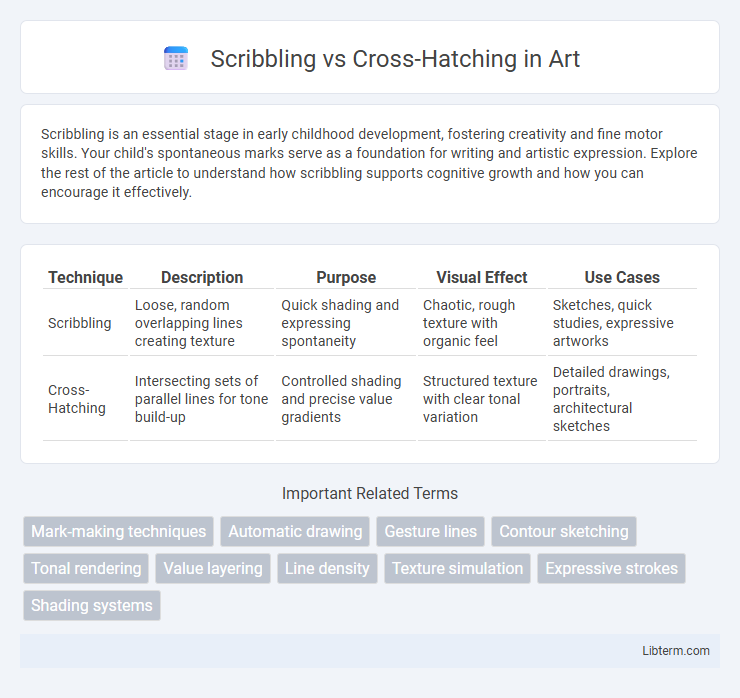Scribbling is an essential stage in early childhood development, fostering creativity and fine motor skills. Your child's spontaneous marks serve as a foundation for writing and artistic expression. Explore the rest of the article to understand how scribbling supports cognitive growth and how you can encourage it effectively.
Table of Comparison
| Technique | Description | Purpose | Visual Effect | Use Cases |
|---|---|---|---|---|
| Scribbling | Loose, random overlapping lines creating texture | Quick shading and expressing spontaneity | Chaotic, rough texture with organic feel | Sketches, quick studies, expressive artworks |
| Cross-Hatching | Intersecting sets of parallel lines for tone build-up | Controlled shading and precise value gradients | Structured texture with clear tonal variation | Detailed drawings, portraits, architectural sketches |
Introduction to Sketching Techniques
Scribbling and cross-hatching are fundamental sketching techniques that enhance texture and depth in artwork. Scribbling involves using loose, random lines to create shading and dynamic movement, ideal for expressive sketches. Cross-hatching employs intersecting parallel lines with varying density to build tonal values and intricate detail.
What is Scribbling in Art?
Scribbling in art is a freeform drawing technique characterized by loose, overlapping, and continuous lines that create texture and shading without strict structure. This method allows artists to express spontaneity and dynamic movement, often used in preliminary sketches or expressive works. Unlike cross-hatching, which employs parallel and intersecting lines with precision, scribbling emphasizes randomness and fluidity to build tonal depth and visual interest.
Defining Cross-Hatching
Cross-hatching is a drawing technique that uses a series of intersecting parallel lines to create shading and texture, enhancing depth and volume in illustrations. Unlike scribbling, which employs random, overlapping strokes to achieve tonal variations, cross-hatching provides precise control over light and shadow through varying line direction and density. This method is essential in classical and contemporary art for rendering detailed shadows and form with clarity and structure.
Historical Origins of Both Methods
Scribbling, rooted in early prehistoric cave drawings, reflects an intuitive, freeform approach that dates back to Paleolithic times, where humans used spontaneous lines to depict motion and texture. Cross-hatching emerged during the Renaissance as a refined technique for shading and depth, pioneered by masters like Albrecht Durer and Leonardo da Vinci, who developed intersecting lines to create tonal gradients and intricate detail. Both methods evolved with artistic demands, illustrating contrasting yet foundational styles in the history of drawing and printmaking.
Tools and Materials Needed
Scribbling requires basic tools such as graphite pencils, pens, or markers, which allow for freeform, overlapping lines to create texture and shading. Cross-hatching demands finer control, often utilizing technical pens, ink, or fine-tipped markers to achieve precise, parallel, and intersecting lines that build tonal value. Both techniques work effectively on smooth or textured drawing papers suited to ink or graphite, with heavier stocks preferred for ink to prevent bleeding.
Key Differences: Scribbling vs Cross-Hatching
Scribbling involves freeform, chaotic lines to create texture and shading, producing a loose and dynamic effect, whereas cross-hatching uses intersecting, controlled lines to build up shading and depth with precision. Scribbling emphasizes spontaneity and expressiveness, while cross-hatching prioritizes structure and gradual tonal variation. The choice between these techniques impacts the artwork's overall texture, detail, and mood, with scribbling offering a more organic feel and cross-hatching delivering refined contrast and dimensionality.
Visual Effects and Textures Achieved
Scribbling produces a loose, irregular texture that creates a dynamic sense of movement and spontaneity, ideal for expressive shading and rough surfaces. Cross-hatching uses intersecting lines to build up layers of varying density, resulting in precise tonal variation and a more controlled, structured texture. These techniques offer contrasting visual effects, with scribbling conveying energy and fluidity, while cross-hatching emphasizes depth and form through meticulous line work.
When to Use Scribbling or Cross-Hatching
Scribbling is ideal for creating loose, spontaneous textures and dynamic shading in quick sketches or expressive drawings, especially when you want to emphasize movement or chaotic elements. Cross-hatching works best for detailed rendering, precise shading, and building tonal values gradually in more controlled, realistic artwork where depth and form are essential. Choose scribbling for energetic, rough textures and cross-hatching for layered, structured shadows and fine gradations in light and dark areas.
Common Mistakes to Avoid
Scribbling often leads to uneven shading and a lack of texture when pressure control and stroke direction are inconsistent. Cross-hatching mistakes include overly uniform lines that reduce depth and dynamic contrast, resulting in flat or mechanical shading. Avoid overlapping lines without variation in angle or spacing to maintain dimensionality and visual interest in both techniques.
Final Thoughts: Choosing the Right Technique
Selecting between scribbling and cross-hatching depends on the desired texture and shading depth in your artwork. Scribbling offers a loose, dynamic feel suitable for expressive sketches, while cross-hatching provides precise, layered tonal variation essential for detailed rendering. Understanding each technique's impact on light and shadow helps artists achieve their intended visual effect efficiently.
Scribbling Infographic

 libterm.com
libterm.com